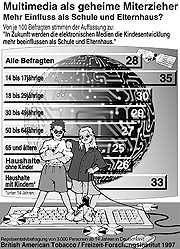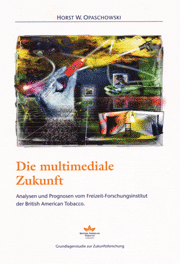The multimedia future
Multimedia as a secret co-educator
More influence than school and parents?
A good quarter of the population in Germany (28%) is now convinced that electronic media influence child development more than school and home. Families with children under the age of 14 are particularly concerned (33%). But the young people themselves also demonstrate a corresponding awareness of the problem: One in three young people (14- to 17-year-olds: 35%) rate the impact of multimedia as a secret co-educator higher than, for example, the influence of full-time educators at home and school. This is the result of a recent representative survey by the Leisure Research Institute of British American Tobacco, in which 3,000 German citizens aged 14 and over were asked about their media habits.
One in three Germans is also convinced that the sensory overstimulation caused by the flood of media will make people more nervous and aggressive. Households with three or more people express more fears in this respect (35%) than single households (28%). And the older generation aged 50 to 64 is more concerned about future increases in aggression (37%) than the younger generation aged up to 29 (27%). Institute Director Prof. Dr Horst W. Opaschowski: "The sensory overstimulation - from the flood of offers to the partly high-tech mediatisation of children's rooms - will have a lasting impact on children's development and social behaviour in the long term."
In future, the main focus of family and school media education must be on how to prevent sensory overstimulation caused by the flood of media in children. This has more to do with behavioural training than with imparting knowledge. Specifically, guidance on how to reduce media consumption can be the most effective media education. This education is directed against overdosed media consumption and in no way calls for media abstinence
Almost three quarters of young people no longer watch TV news
TV programmes are becoming more and more similar because TV channels are imitating each other in the hunt for ratings. News and political programmes are in danger of falling by the wayside. Since the beginning of the 1990s, more entertainment programmes (1991: 36% - 1997: 42%) and talk shows (1991: 6% - 1997: 11%) have been watched in West Germany, while news (1991: 82% - 1997: 69%) and political magazines (1991: 19% - 1997: 7%) have seen significant declines over the same period.
TV news is losing more and more followers, especially among the younger generation. Society and politics cannot remain indifferent to this development. Almost three quarters of all young people in Germany (1997: 72%) did not watch a single news programme yesterday evening. Young people are therefore coping with the flood of information in a very special way: They refuse to watch and are more likely to switch off news programmes on television than to select them. TV news: "No, thanks!" - a challenge for democracy, political education and, above all, for new ideas from the responsible producers.
Young viewers in particular can no longer stay with one thing for long. If a news programme becomes boring or exhausting, consumers simply jump on - from one channel to another. The remote control symbolises the growing impatience and hopping mania of the new TV generation. With its help, the viewer can move back and forth between the individual programmes at any time:
- Three quarters of all TV viewers regularly use the remote control during an evening of television.
- Almost every third viewer (31%) hops back and forth between TV programmes at least five times a night on average.
- Every ninth viewer (11%) has a hopping frequency of - nine times per evening or even more.
The trend is still rising: in 1994, 63 per cent of TV viewers were hoppers, in 1997 it was 76 per cent. Men make significantly more use of the remote control (81%) than women (73%). The absolute hopping freaks, however, are the 14 to 19-year-olds. 85 per cent are not satisfied with one TV programme in the evening, they simply "have to" switch back and forth
Shifts in the quality of TV programmes are becoming apparent. "The TV flattening spiral means that viewers are simply switching to flatter programmes," says Prof. Dr Horst W. Opaschowski. "A kind of lift effect is emerging: The TV programmes are taken down a level." The tendency is for entertainment to win out over information, and makers and makers, producers and consumers alike are coming to terms with the drop in quality.
The consequences of media overstimulation: the child becomes a scanner
The psychosocial consequences are inevitable. Due to the abundance and variety of offers, many impressions and information can only be absorbed side by side like confetti. Professor Opaschowski: "Characteristics of a confetti generation. Impressions remain fragmented and superficial. Torn between scraps of words and image fragments, in the end they have heard and seen very little that is coherent." As we become accustomed to the constant barrage of new stimuli, even the extraordinary takes on the character of something passing by - on the way to the next event. As soon as something threatens to become uninteresting, the new media generation simply skips ahead.
The speed of today's media (MTV, video software, multimedia computer programmes, etc.) overwhelms children and young people with an ever faster succession of images and information. As a result, our culture is producing a whole new media generation - the "short-term concentration kids". This generation is developing very specific concentration strategies so that they can process the flood of images and the speed of information at all. The child becomes a scanner, i.e. growing up in an environment flooded with stimuli forces the child to scan its own life as well. As with a scanner, the child reads the multitude of visual and acoustic signals in life selectively and subjectively in order to be able to process and store the impressions psychologically. A new life technique must be mastered or learnt: Scanning - this enables the child to defend itself against too much stimuli by only perceiving what seems personally important to it. Everything unimportant is faded out and there is simply no time for the boring stuff.
Internet ’97: Lots of wind and few surfers - most consumers refuse to surf
The information age is coming. And with it the computerisation of all private households. The multimedia industry's vision for the future is clear: the home will become a cyber world. And our entire lives will revolve around the Internet. But the makers have obviously done the maths without the takers. Most private customers refuse to do so: only two per cent of Germans (no change in 1997 compared to 1996) occasionally surf the world on the Internet, while 92 per cent prefer to regularly zap through the programmes on television.
"After work, Germans are primarily looking for relaxation and distraction," says Prof Dr Opaschowski. "They want to be entertained, entertained and entertained by television, but not annoyed by slow data transfers on the Internet." The industry has so far failed to turn the PC into an entertaining mass medium. Only when the industry succeeds technologically and psychologically in combining PCs and the Internet with TV, video and stereo will a new multimedia world of experience emerge. The electronic revolution in the living room will begin when private online services are just as easily accessible as the TV remote control. Opaschowski: "Private net surfing must be manageable like a toy if it is to have a mass media future."
PC use: prefer game programmes to programming
The survey is based on 3,000 interviews conducted in Germany in February 1997: 22 per cent of Germans own a computer, 14 per cent use it regularly at home, but only two per cent log on to the Internet once a week. The electronic data networks are very much in vogue, Germans prefer to lie on their lazy skin.
The main reasons for this are not just convenience or a lack of time, but above all a lack of skills: cyberspace is populated almost exclusively by the highly educated. The problem-free data search in the blink of an eye is mainly dominated by high school (8%) and university graduates (9%), while the proportion of secondary school and primary school graduates is less than 0.5 per cent. The typical Internet users are also not 14 to 17-year-old kids (2%), but rather young adults aged 20 to 24 (7%).
Leisure-orientated PC consumers could travel around the world online in five seconds. But they think little of clicking into the future. Most of them only use their PC as a typewriter for writing letters (17%) or have fun with games programmes (12%). Programming (3%) and database applications (4%) or image and music editing (2% each) are more the exception than the rule.
In ’97, the information highway does not resemble a data highway, but rather a beaten track in which a few electronically educated people are virtually lost. Only one in fifty is an Internet user, only one in a hundred a tele-shopper. For the majority of consumers, video games are easier and television more convenient.
Growing media literacy: fear of the multimedia age is decreasing
A comparison of the last two years shows that the fear of the multimedia age in Germany is slowly receding. Fewer and fewer Germans are mourning the old ARD and ZDF days (1996: 32% - 1997: 27%). The fear of loneliness is also decreasing (1996: 57% - 1997: 55%). And even the group of opponents who do not want the wide range of media on offer is no longer growing (1996: 39% - 1997: 39%). The signs of a downward trend in media phobia are increasing. Information campaigns on a broad scale and the growing media competence of the younger generation are taking the edge off the acceptance problems.
However, the media world remains divided. The war and post-war period has led to the emergence of two generations of technology:
- The majority of older people resist and oppose the new multimedia offering.
- Younger people, on the other hand, are much more positive about the multimedia options for privacy.
The opportunities of the future multimedia age are recognised by the older generation, but their significance is rated as relatively low. The young generation of 14 to 29 year olds is quite different. In their assessment, the opportunities and risks of the future multimedia age almost balance each other out. The young generation is the bearer of hope. A good third of young people hope that this will enrich their private lives (36%), that the new technologies will make life more pleasant and easier (39%) and that new jobs will be created (32%).
The fact that the younger generation has a much more positive view of the future of multimedia than the rest of the population certainly gives cause for hope. However, it is also unmistakable here: The disadvantages and risks of media development are sometimes considered to be just as serious as the potential opportunities. And one in four young people are realistic and say: "There is not enough time to make use of it" (26%). Professor Opaschowski: "In vision, everything is possible. In technology, many things are feasible. But in reality, there are only two questions: Where are the people? And: What does the consumer want?"
The question of how promising or risky the multimedia future will be will not only be decided by the younger generation. Further development depends to a large extent on how quickly it is possible to facilitate general access to multimedia offerings and ensure their dissemination. Those who are not familiar with the new information technologies express more fears and anxieties about the future information society than competent PC users. Compared to non-PC users, for example, the proportion of PC users who believe that new jobs will be created is more than twice as high (41% compared to 17%). Fear of the future also results from a lack of knowledge. And hopes for the future grow with expertise.
The study "The multimedia future. Analyses and Forecasts" is available for a nominal charge of DM 39 from the beginning of June 1997 from the Leisure Research Institute of British-American Tobacco (Germany) GmbH, Alsterufer 4, 20354 Hamburg. We will provide journalists and editorial offices with a review copy free of charge on request.
See also directory of all publications




